上海初中牛津英语7AU1教案提高版
牛津初中英语7A Unit1教案
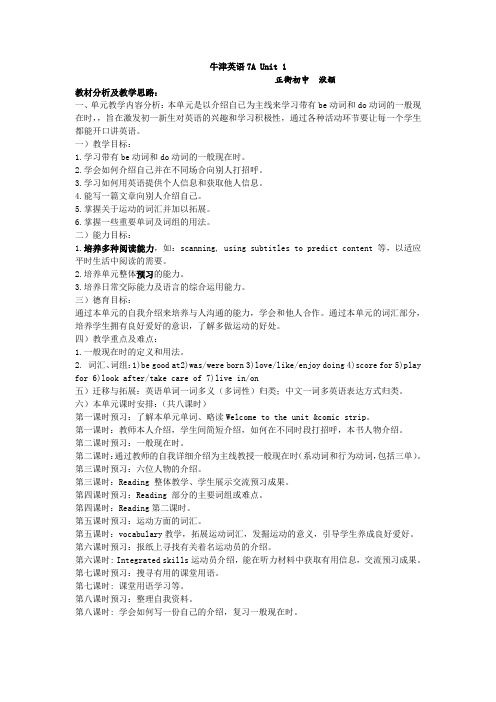
牛津英语7A Unit 1正衡初中洑颖教材分析及教学思路:一、单元教学内容分析:本单元是以介绍自已为主线来学习带有be动词和do动词的一般现在时,,旨在激发初一新生对英语的兴趣和学习积极性,通过各种活动环节要让每一个学生都能开口讲英语。
一)教学目标:1.学习带有be动词和do动词的一般现在时。
2.学会如何介绍自己并在不同场合向别人打招呼。
3.学习如何用英语提供个人信息和获取他人信息。
4.能写一篇文章向别人介绍自己。
5.掌握关于运动的词汇并加以拓展。
6.掌握一些重要单词及词组的用法。
二)能力目标:1.培养多种阅读能力,如:scanning, using subtitles to predict content等,以适应平时生活中阅读的需要。
2.培养单元整体预习的能力。
3.培养日常交际能力及语言的综合运用能力。
三)德育目标:通过本单元的自我介绍来培养与人沟通的能力,学会和他人合作。
通过本单元的词汇部分,培养学生拥有良好爱好的意识,了解多做运动的好处。
四)教学重点及难点:1.一般现在时的定义和用法。
2. 词汇、词组:1)be good at2)was/were born 3)love/like/enjoy doing 4)score for 5)play for 6)look after/take care of 7)live in/on五)迁移与拓展:英语单词一词多义(多词性)归类;中文一词多英语表达方式归类。
六)本单元课时安排:(共八课时)第一课时预习:了解本单元单词、略读Welcome to the unit &comic strip。
第一课时:教师本人介绍,学生间简短介绍,如何在不同时段打招呼,本书人物介绍。
第二课时预习:一般现在时。
第二课时:通过教师的自我详细介绍为主线教授一般现在时(系动词和行为动词,包括三单)。
第三课时预习:六位人物的介绍。
第三课时:Reading 整体教学、学生展示交流预习成果。
牛津英语7AUnit1分课时教案
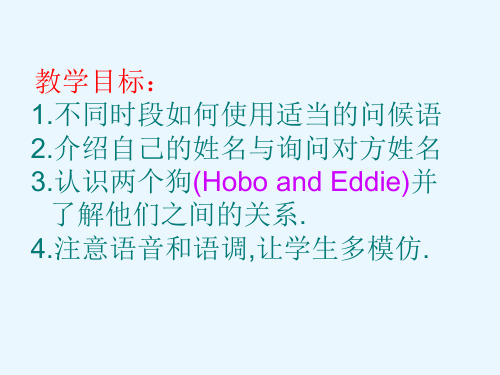
❖ Amy has long hair. F
❖ Daniel wears glasses. T
Task 7
Reading the passage again. Making notes about Millie’s new classmates. (Do p10 C1)
Task 7- Writing the notes.
p.m. Good afternoon.
a.m. Good morning.
p.m. Good night.
p.m. Good evening.
How to greet your friends at the following time? 8:00a.m 10:30a.m 4:30p.m 11:00p.m
Good.Read this book now.
Task Six: Reading the dialogue and
acting it out in pairs.
根据问/答句完成对话:
1.A:_____________________? B: I’m
Sally.
2.A: Good morning.
Homework: 1.Copy new words and phrases. 2.Greet your friends at different time. 3.Recite the dialouge.
本课时设计目的:
通过对文章的阅读,教会学生如何找出具体 信息.培养阅读技巧,注重阅读策略的培养,整体感 知语言的能力.
Task 2 warming up
Presenting some new words and phrases. ❖ …years old ❖ come from –be born in ❖ tall –short -slim ❖ like-love-enjoy-be good at … ❖ work hard
沪教牛津版 7AU1-2 Listening and speaking教案

课题:广深沪教牛津版七年级上册
Unit1Makingfriends:ListeningandSpeaking
Learning Objectives:
By the end of the class, students will be able to
1.listenfor specificinformationabout an e-friend.
Studentslisten to the song andthenthink about making friends.
Lead in the topic and arouse students’ interestinmaking friends.
Step2:
Pre-Listening
Guidestudents toguesswhat kind of questions they may hear in the conversation.
Step4:
Post-Listening
1.Retelh help of the mind map.
2.Interview
Ask students to make a new dialoguebetween Jason and Mandywith the help of the sentence patterns.
1.Studentstalk about Yuki in their own words.
2. Studentsmake a new dialogue between Jason and Mandywith the help of the sentence patterns.
1.Let students practisehow to introduce a personand get ready for thespeakingactivity.
上海牛津版英语7au1u7教程文件

上海牛津版英语7a U1-u7
Self-reflection:
作为七年级第一单元,M1U1在知识内容上是起到对六年级旧知识的衔接和过渡。
在实践中教师发现,现在完成时依然是重点,同时也是部分同学的认知难点。
课后,教师反思教学过程,感到必须在今后教学中强调板书的作用,通过更清晰明确而简单醒目的表格,帮助学生了解和掌握现在完成时的基本结构,然后结合课堂教学实践,加强和深化学生实际运用该时态的能力。
此外,形容词的比较级也是本课的一大重点,尤其是多音节形容词转换成比较级时,学生在课堂上出现了较多错误,说明这也是教案应该强化训练和引导的地方。
How 提问的句子,尤其是how long对时间的提问句型,对部分学生而言造成了困难,如能修改教案和课件的相关内容,相信对更好地帮助全体学生掌握该知识点会有一定作用。
第四课时出现了一个新知识点:介词所搭配的方位表达方式。
在实践中,教师发现图形示意是很有效的教学方法,绝大部分学生能够迅速从示意图中理解教师的意图,较好地掌握方位的表达方式,反映在课堂问答中,出现错误的情况很少。
第五课时要求学生模仿课文写作,尤其是信件格式,对帮助学生建立起写作时结构安排的意识很重要,从实践情况来看,大部分学生能够在本课时的引导下,完成结构合理、内容较为翔实、语法基本正确的作文。
牛津版7AUnit1MainTask教学设计
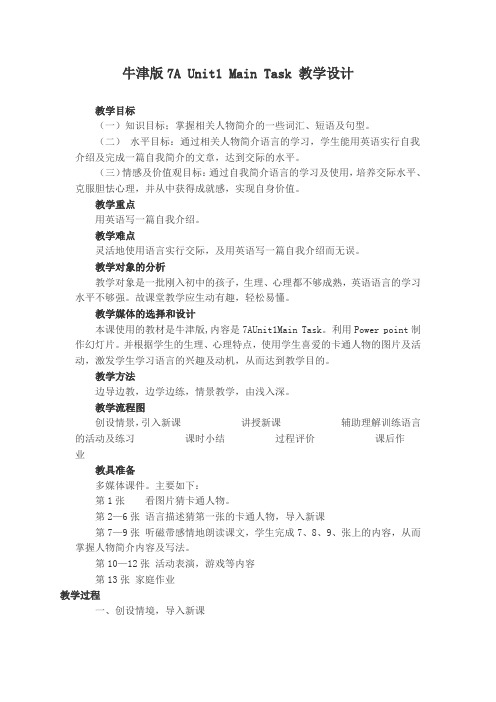
牛津版7A Unit1 Main Task 教学设计教学目标(一)知识目标;掌握相关人物简介的一些词汇、短语及句型。
(二)水平目标:通过相关人物简介语言的学习,学生能用英语实行自我介绍及完成一篇自我简介的文章,达到交际的水平。
(三)情感及价值观目标:通过自我简介语言的学习及使用,培养交际水平、克服胆怯心理,并从中获得成就感,实现自身价值。
教学重点用英语写一篇自我介绍。
教学难点灵活地使用语言实行交际,及用英语写一篇自我介绍而无误。
教学对象的分析教学对象是一批刚入初中的孩子,生理、心理都不够成熟,英语语言的学习水平不够强。
故课堂教学应生动有趣,轻松易懂。
教学媒体的选择和设计本课使用的教材是牛津版,内容是7AUnit1Main Task。
利用Power point制作幻灯片。
并根据学生的生理、心理特点,使用学生喜爱的卡通人物的图片及活动,激发学生学习语言的兴趣及动机,从而达到教学目的。
教学方法边导边教,边学边练,情景教学,由浅入深。
教学流程图创设情景,引入新课讲授新课辅助理解训练语言的活动及练习课时小结过程评价课后作业教具准备多媒体课件。
主要如下:第1张看图片猜卡通人物。
第2—6张语言描述猜第一张的卡通人物,导入新课第7—9张听磁带感情地朗读课文,学生完成7、8、9、张上的内容,从而掌握人物简介内容及写法。
第10—12张活动表演,游戏等内容第13张家庭作业教学过程一、创设情境,导入新课告诉学生将收集每个学生的简介集成册,并送给每位老师和学生及交换留学生作为留念。
所以今天将学写个人简介。
首先看幻灯片上的人物图片,给出一个简介例子,从而导入新课,介绍Millie和Daniel二、激发兴趣,出示卡通幻灯图片,讲授新课Step1 Guess who they are.看第1张幻灯图片猜卡通人物。
通过生动形象的卡通幻灯图片猜卡通人物,吸引了学生的注意力,激发了他们的兴趣。
三、发展水平,出示幻灯图片语言描述猜卡通人物Step2 看第2—6张幻灯图片语言描述猜卡通人物,导入新课。
牛津上海版英语七年级上册Unit1教学设计

一、教学目标
(一)知识与技能
1.学生能够掌握本章节的核心词汇和基本句型,如:hello, good morning, good afternoon, good evening, how are you, my name is, nice to meet you等,并能熟练运用到日常交流中。
4.通过师生互动、生生互动,让学生在实际语境中练习新学的词汇和句型。
(三)学生小组讨论
1.教师将学生分成小组,每组选定一个话题,如:自我介绍、询问对方基本信息等。
2.小组内成员用英语进行讨论,尽量运用新学的词汇和句型。
3.每个小组派一名代表进行汇报,展示讨论成果,其他小组成员进行评价。
(四)课堂练习
3.增强学生的自信心,使他们相信自己能够通过努力学会英语,为今后的学习打下坚实基础。
4.培养学生具备国际视野,了解并尊重不同国家的文化差异,为成为具有国际竞争力的优秀人才奠定基础。
5.引导学生树立正确的价值观,认识到学习英语的重要性,激发他们为国家和民族的发展贡献力量的责任感。
二、学情分析
针对牛津上海版英语七年级上册Unit1的教学内容,结合学生的年龄特点和英语学习水平进行分析。七年级学生正处于青春期,思维活跃,好奇心强,对新鲜事物充满兴趣。然而,他们在英语学习方面的基础知识相对薄弱,尤其在口语表达和听力方面存在一定困难。
4.通过听力、口语、阅读、写作等多种练习方式,帮助学生全面掌握本章节的知识点。
5.注重个体差异,给予每个学生充分的关注和指导,使他们在原有基础上得到提高。
(三)情感态度与价值观
1.培养学生热爱英语,积极参与课堂活动的兴趣,激发学生学习英语的内驱力。
提高学生的人际交往能力。
上海版牛津英语七年级第一学期 7AModule1Unit4教案设计(5课时)

Module 2 My neighbourhoodUnit 4 Jobs people doTasks in this unit:Talking about people’s jobs: where people work and what they do; talking about work routines; doing a survey of people’s job and writing a report; reading about an accident and the people who help; compiling a page of common jobs and illustrating them. Language focus:Using nouns to identify peoplee.g., Mrs Wang is a doctor.Using the simple present tense to talk about habitual actionse.g., She works in a hospital.Language skills:Listening:Identify details that support a main ideaSpeaking:Open an interaction by eliciting a responseReading:Read written language in meaningful chunksWriting:Gather and share information and ideas by using strategies such as brainstormingEpisode oneTeaching procedureModule 2 My neighbourhoodUnit 4 Jobs people doLanguage focusUsing the simple present tense to describe habitual actionse.g., Who wears a uniform at work?Language skillsListeningIdentify details that support a main ideaSpeakingUse appropriate intonation and stress to convey intended meanings ReadingRe-read to establish and confirm meaningsEpisode TwoTeaching procedureModule 2 My neighbourhoodUnit 4 Jobs people doLanguage focusAsking Wh-questions to find out specific informatione.g., What’s your job?Asking Wh-questions to find out placee.g., Where do you work?Using the simple present tense to describe habitual actionse.g., I answer the phone.Language skills:ListeningIdentify main ideas in a new topicSpeakingOpen and maintain an interaction by asking and answering questions ReadingIdentify details that support a main ideaWritingGather and share information and ideas by using strategies such as interviewingEpisode ThreeTeaching procedureModule 2 My neighbourhoodUnit 4 Jobs people doLanguage focusUsing the simple past tense to talk about past actionse.g., …a motorcycle came towards Ben and knocked him downUsing adjectives to describe conditionse.g., Ben had a broken arm…Language skillsListeningListen for specific informationSpeakingUse appropriate intonation and stress to convey intended meanings and feelings ReadingRead written language in meaningful chunksEpisode FourTeaching procedureModule 2 My neighbourhoodUnit 4 Jobs people doLanguage focusUsing the simple present tense to describe habitual actionse.g., He sees the street cleaners cleaning the streets.Using adverbs of timee.g., They start work early.Language skillsListeningListen for specific informationSpeakingUse appropriate intonation and stress to convey intended meaningsReadingRead written language in meaningful chunksWritingPlan and organize information and ideas by deciding on the sequence of contentEpisode FiveTeaching procedure。
牛津英语7AUnit1教案

Ask: How old is Millie
Does she like reading
In the same way to learn sth. About Simon and Sandy etc.
Ask the Ss to read again and finish Part B on Page 9 and
Answerthe questions.
Ss fill in the blanks and check it.
可以开展小组比赛,激发学生的热情。
让学生独立完成检查掌握情况。
Step 3Practise
Step 4 Test
Step 5:
Homework
.
Tell students to work in pairs to complete the chart. Then ask students to make their own sentences about the sports that they have written down in the table.
Draw this table on the small blackboard. Use “swimming” as an example. Then ask students to draw the following table on the paper.
say the names of the sports.
能力目标
2 To learn to use the simple present tense to talk about things.
情感目标
上海版牛津英语七年级第一学期 7AModule1Unit1教案设计
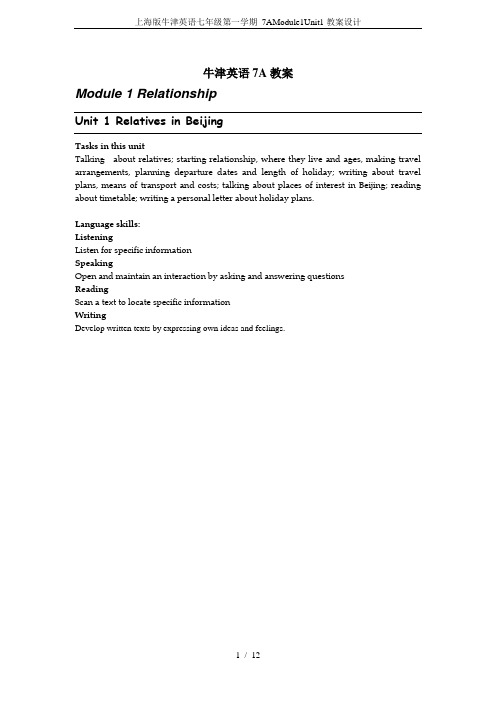
S1:When are we going to visit ___?
S2:We’re going to visit ___ on ___.
S1:How long are we going to stay there?
S2:We’re going to stay there for ___. We’re going to come back ___.
牛津英语7A教案
Module1 Relationship
Unit1Relatives inBeijing
Tasks in this unit
Talking about relatives; starting relationship, where they live and ages, making travel arrangements, planning departure dates and length of holiday; writing about travel plans, means of transport and costs; talking about places of interest inBeijing; reading about timetable; writing a personal letter about holiday plans.
Why won’t they take the train there?
5.Read and write
The Lis have decided to go toBeijing. Mr/ Li is going to write a letter to his brother, Wein\ming. Can you help him to complete the letter to Uncle Weiming?
牛津上海版英语七年级上Unit1 Relatives in Beijing教案

牛津上海版英语七年级上7A Module 1 Unit 1Relatives in Beijing一. 单元分析( Unit Analysis)(一) 单元地位( Unit position)1. 本单元在时态上的一个重点在与现在完成时的拓宽与延伸。
现在完成时在6B Module 2中学生已经学过,并以肯、否、一般疑问句及其简单回答和特殊疑问句的形式出现在Unit 2和Unit 3,同时还加入了一些副词,如:just, already, yet.。
但在当时的教学中,语言情景仅局限在涉及“去过某地”(即have been to +地点)。
本单元在动词的选择上,扩大了范围,增加了诸如:have had, have visited, have seen 等其它动词,这就要求在教学时,要适当扩充动词的过去分词,尤其要注意拼写。
本单元还增加了never在现在完成时的使用,以及主语为第三人称单数的特殊情况。
因此,本单元在现在完成时的教学中起到了深化和承上启下的作用,学习好本单元对学生在以后的现在完成时,乃至过去完成时的学习时都起到很重要的铺垫作用。
2.本单元在将来时方面,也让学生从原来学过的be going to do …拓宽到了will do…。
3.形容词的比较级,在6A 和6B中多次出现,本单元的复现,应是一个强化,教师可做适当的拓宽。
4.关于the same的表达曾在6 A Module 1的Unit 1和Unit 2中出现,本单元在原来的基础上,增加了the same…as的表达。
5. Would like to do …的句型在6 A和6 B中也多次出现。
在本单元中,可结合want to do…一起教学。
6. 注意某些问时间(How long),问价格(How much),问方式(How)等疑问句及回答的用法。
让学生这些方面的问答操练后巩固掌握它们。
7. 本单元的情景内容较为实用,涉及到外出旅游的计划打算、出游安排准备、询问价格、所需花费时间的问答、交通方式的比较、机场接机、景点介绍等;在句式上用到了提建议的多种方式;甚至还出现了较为简单的感叹句。
上海牛津英语7a教案
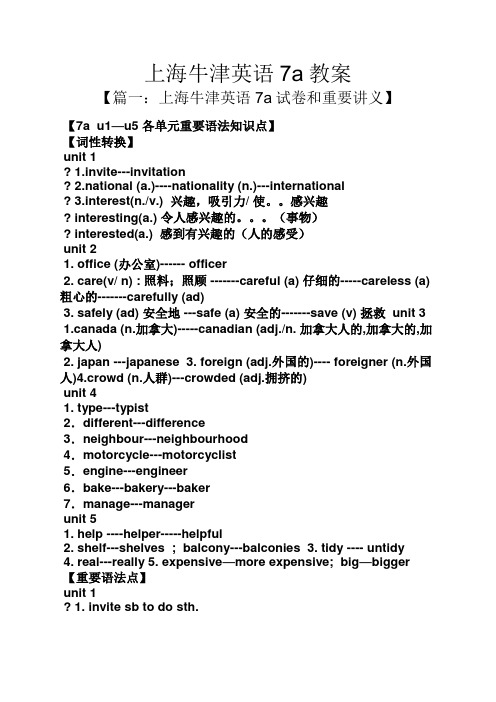
上海牛津英语7a教案【篇一:上海牛津英语7a试卷和重要讲义】【7a u1—u5 各单元重要语法知识点】【词性转换】unit 1? 1.invite---invitation? 2.national (a.)----nationality (n.)---international? 3.interest(n./v.) 兴趣,吸引力/ 使。
感兴趣? interesting(a.) 令人感兴趣的。
(事物)? interested(a.) 感到有兴趣的(人的感受)unit 21. office (办公室)------ officer2. care(v/ n) : 照料;照顾 -------careful (a) 仔细的-----careless (a) 粗心的-------carefully (ad)3. safely (ad) 安全地 ---safe (a) 安全的-------save (v) 拯救 unit 3 1.canada (n.加拿大)-----canadian (adj./n. 加拿大人的,加拿大的,加拿大人)2. japan ---japanese3. foreign (adj.外国的)---- foreigner (n.外国人)4.crowd (n.人群)---crowded (adj.拥挤的)unit 41. type---typist2.different---difference3.neighbour---neighbourhood4.motorcycle---motorcyclist5.engine---engineer6.bake---bakery---baker7.manage---managerunit 51. help ----helper-----helpful2. shelf---shelves ; balcony---balconies3. tidy ---- untidy4. real---really5. expensive—more expensive; big—bigger 【重要语法点】unit 1? 1. invite sb to do sth.? 2. talk to/ with sb. ? 4. talk about sth. (talk to sb about sth) ? 3. on+具体几月几日,on aug.16/ on 16 august 注意读音 ? 4. thank you for+ n.----thank you for your help. thank youfor+ doing---- thank you for writing to me. ? 5. more than = over 超过? 6. the summer palace; the great wall ; the palace museum ? tian’anmen square; yu garden7. see sb doing sth.与 see sb do sth 之间的区别? 8. it takes me 2 hours to finish my homework.?how long does it take you to finish your homework?9. 现在完成时态简单介入:例如: they ha ven’t been to the usa before.i haven’t finished my homework yet.she has already cleaned the classroom.10. another例如:this book is too difficult for me. will you please give me another one?unit 21. have no food or water 在否定句中and应改为“or”2. take sb to somewhere 带某人去某地3. take care of = care for = look after 照顾,照看4. buy sb sth = buy sth for sb 为某人买某物5. save animals from danger 把动物从危险中解救出来6. promise to do 承诺做某事7. 一般过去时态介入8. 名词+ to do,to do 用来补充说明用途例如:give him some water to drink;give him a blanket to keep warm;give it a basket to sleep inunit 31. six million 注意数字表达法:例如:2,700,560 two million seven hundred thousand five hundred and sixty2. 注意国家名称和国籍的区别。
(完整版)沪教牛津版初中英语七年级上册全套教学案

(完整版)沪教⽜津版初中英语七年级上册全套教学案7A UNIT 1 Making friendsⅠ重点单词:world n. 世界country n. 国家Japan n.⽇本Germany n. 德国German adj.德国的n.德国⼈grammar n.语法 blog n. 博客sound n. 声⾳everyone n.⼈⼈(谓语动词要⽤单数)hobby n.爱好(复数hobbies)age n. 年龄elder adj. 年长的dream n. 梦想complete v. 完成us pron.我们 yourself pron.你⾃⼰friendly adj. 友爱的engineer n. ⼯程师 flat n.公寓mountain n. ⼭Ⅱ重点短语:1.colse to 接近 = near 反义词:far (away)from 远离2.go to school 去上学3.be good at 擅长 =do well in 反义词:be bad /poor at=do badly in不擅长4.make friends with 与……交朋友 make friends 交朋友5.all over 遍及6.I’d like to=I would like to 愿意Ⅲ重点句型:1.what does···mean?2.welcome to3.I like···because···4.My dream is to be··.5.How old is/are ····?6.What does ····do?Ⅴ详细讲解:1.Read a G erman girl’s blog.(Page1)(1)German :① adj.德国的(德国⼈的,德语的)This is a German car.② n.德国⼈,是可数名词。
上海牛津版英语七年级上册七上7AUnit1U1同步作业教案
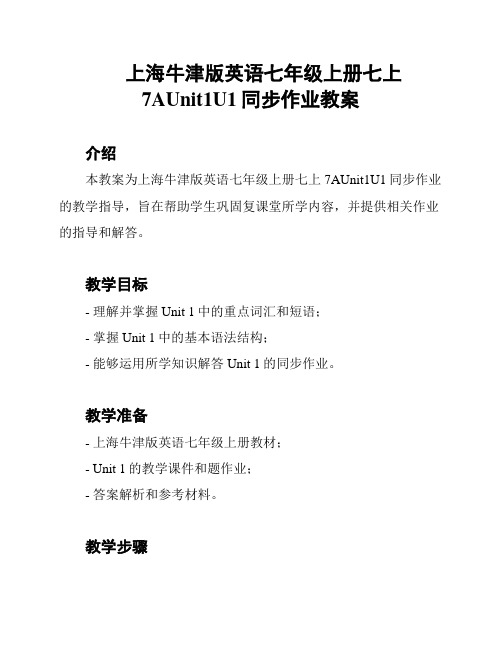
上海牛津版英语七年级上册七上
7AUnit1U1同步作业教案
介绍
本教案为上海牛津版英语七年级上册七上7AUnit1U1同步作业的教学指导,旨在帮助学生巩固复课堂所学内容,并提供相关作业的指导和解答。
教学目标
- 理解并掌握Unit 1中的重点词汇和短语;
- 掌握Unit 1中的基本语法结构;
- 能够运用所学知识解答Unit 1的同步作业。
教学准备
- 上海牛津版英语七年级上册教材;
- Unit 1的教学课件和题作业;
- 答案解析和参考材料。
教学步骤
1. 复:通过课堂讨论和互动复Unit 1中的重点词汇和短语,并
梳理相关知识点。
2. 指导:逐步指导学生完成Unit 1的同步作业,解答学生遇到
的问题。
3. 检查:检查学生完成的作业,批改并给予反馈。
4. 总结:总结本节课的研究内容,强调重要知识点和注意事项。
附加练
为了进一步巩固所学知识,学生可以完成一些附加练,包括课
后练册中的相关题或在线练平台上的练。
教学反思
本节课通过复和指导,帮助学生巩固复课堂所学内容,并解答
同步作业中的问题。
针对学生的不同需求,可以适当调整教学步骤
和练内容,提供更多个性化的教学支持。
同时,教师应及时反馈学
生作业,帮助他们发现错误并提供正确的指导。
牛津上海版七年级英语上册教学设计:Unit1RelativesinBeijing

4.能够运用本节课所学的句型,进行简单的自我介绍和描述家庭成员的情况,提高口语表达能力。
5.能够阅读并理解与本节课主题相关的短文,获取关键信息,提高阅读理解能力。
(二)过程与方法
1.通过小组合作、讨论、分享等形式,培养学生主动参与、积极思考的学习习惯。
牛津上海版七年级英语上册教学设计:Unit1RelativesinBeijing
一、教学目标
(一)知识与技能
1.能够听懂、准确说出并运用本节课所学的生词和短语,如“cousin”、“aunt”、“uncle”、“grandparents”、“live in”等,并能在实际情境中进行正确运用。
2.能够运用一般现在时描述家庭成员在北京的生活情况,如“My grandparents live in Beijing.”。
3.情境练习:设计一些情境,让学生运用一般现在时描述家人在北京的生活情况,如“My grandparents live in Beijing.”。
(三)学生小组讨论,500字
1.分组活动:将学生分成小组,让他们根据所给情境,运用所学词汇和句型讨论家人在北京的生活。
2.交流分享:每组选一个代表进行分享,其他小组成员倾听并给予评价。在此过程中,鼓励学生积极参与,提高他们的口语表达能力。
4.利用多媒体教学资源:运用图片、视频、音频等多媒体资源,丰富教学手段,激发学生的学习兴趣,提高课堂教学效果。
5.重视过程性评价:在教学过程中,关注学生的学习过程,及时给予鼓励和指导,帮助他们建立自信,培养良好的学习习惯。
6.教学步骤:
(1)导入:通过展示北京的风光图片,引导学生谈论对北京的了解,激发他们对本节课主题的兴趣。
上海牛津版英语七年级上册七上7AUnit1U1同步讲义教案

学员编号:年级:课时数:学员姓名:辅导科目:英语学科教师:授课类型T Unit1(牛津7上)同步梳理教学目标1、使学生能够基本掌握牛津7年级上册Unit1中的基础词汇及重要句型;授课日期及时段T同步-U1基础知识梳理(建议时间:5分钟)Uncle Weiming 给Ben家打来电话,邀请他们家八月份去北京玩,现在让我们来看看,the Li family 暑假是怎么去的北京,行程是怎么安排滴吧~~~想要去北京看看么?为了去游览北京---我们伟大祖国的首都时,不至于被朋友们笑话,快跟着老师一起来看看北京又哪些好玩的地方,怎么样去北京既方便又快捷,去北京游玩要注意些什么吧。
一、词汇Words (建议20分钟,老师边讲边要求学员记住单词,此环节结束之后要求学员记住80%)1. invite v. 邀请e. g. I’ve invited the Smiths to visit us next Friday. . 我已经邀请史密斯一家下周五来家玩。
He invited some classmates to come to his birthday party.【知识拓展】invitation n. 邀请函;请柬批注:很多孩子分不清楚invite和invent,在学到invite单词的时候一定要将invent一起复习下。
考点:invitation 名词词组invite sb. to do sth1. The summer holiday is coming. I will my cousins to visit the Great Wall. (invitation)2. My mother i us to stay with his family. (首字母填空)3. Thank you for (to invite/inviting) me to visit you.4. Have you got my (invite) yet?2. expensive adj. 昂贵的e. g. I think international calls are very expensive. 我认为国际电话费用很高。
牛津英语7Aunit1教案

牛津英语7A unit1教案Unit 1 This is meTeaching aims: To introduce oneselfTo use appropriate greetingsTeaching main points: greetingsTeaching difficulties: understanding of “master’ ‘instruction book’ and ‘look after’Teaching procedures:Step1 GreetingsStep2 RevisionStep3 Presentationintroduce myself. Say ‘Good morning, I am Miss Yu.Get Ss to talk in a non-intimidating environment, to start with simple greetingsExplain to Ss that they are meeting six Ss in Beijing. Ask them to look at the people in Part A and identify them by name.Ask: what are their names?Do they have English names? What are their names?Can you tell me the names of the boys and the girls?Step4 PracticePractise saying the names of the central characters.Step5 Reading.Read the conversation to the class using different voices.Read the sentences one at a timeSs read afterChoose six Ss to read one sentence each or divide the class into pairs. Then they read the conversation to each other.Step6 PracticeAsk Ss to do PartB1 alone.Ask Ss to do PartB2 in pairs to practise introducing oneselfHomework.Tell Ss to draw two scenes of people meeting each other. Ask them to draw speech bubble containing proper greetings.ReadingTeaching main points: I’m /This isSome important words & expressionsTeaching difficulties:To recognize the use of language in giving personal informationTo use personal pronounsTeaching procedures:Step 1 GreetingsStep2 RevisionReview key vocabulary according to the general ability of the classStep3 ReadingRead all the text to the class. Ss listen and follow the text in their booksAsk Ss to read the assigned profile on their own and underline the words they don’t know. Go through the words Ss have underlinedRead after the tapeStep 4 Read and writeRead the passage again, write the following on the board, for Ss to copy. Say find out five things about the assigned character.Name:________________Where does he/she live/come from?What does he/she like?What does he/she look like?Age:___________Step 5 ConsolidationB. New classmatesReview adj. and nouns that describe hair and the structure ‘to have’ as a brainstorming exercise. Ask Ss to look at the table on page5 and check their understanding by asking questions:Who likesfootball/basketball/swimming?Who has a cousin?Tell the Ss to read the passage again to check for specific information.C.Set this task as a quiz. Divide the class into two pairs and the pair who gets all the correct answers first is the winner.Ask Ss to correct the false statement.D. Getting to know the SsRevise some key words. Ask the class some open Qs:Who likes reading?Who likes to listen to music?Ask Ss to complete partD1 from memory. Ask ss to check their answers with their partners. Ask Ss to complete a profile of himself/herself in PartD2.Homework:Ask Ss to work in pairs and write profiles of each other.V ocabularyTeaching main points: 1 teach some nouns and verbs2. sports and equipmentTeaching difficulties: 1. to use verbs and nouns to talk about sports2. to describe different kinds of sportsTeaching procedure:Step1 Greetings and revisionStep2 PresentationTalk about sports with the classAsk Ss to complete Part A. Check the answers orallyTeach the words ‘football boots’ ‘swimsuit’ before they do Part BAsk Ss to complete the sentences on their own. Ask several Ss to read out their answersStep3 ConsolidationDraw the table on the boardSport: swimmingWhere; swimming poolSpecial clothes: swimsuitEquipment: gogglesTeam sport: NThen ask to add more columns for one sportAsk Ss to copy the table, tell them think of more sports to add to the table Homework:Ask Ss to make their own sentences about the sports that they write down in the table, e.g. I play badminton with a badminton racket.GrammarObjectives:1. To make positive and negative statements and ask Qs with the verb ‘to be’2. Learn to use the simple present tense to talkTeaching main points:1.Simple present tense2. How to add-s/-es / ies to the verbs3. Simple present tense of the verb ‘to be’Step1 Greetings & revisionStep2 PresentationGive Ss some examples in order to help them get to know the simple present tense e.g. Cats eat fish..Millie lives in Beijing.He plays football after school.Tell them that we use the simple present tense to talk about things thatare always trueare true nowwe do regularly (habits, jobs, school work ,etc.)Give Ss more examples and ask them to make more sentencesLet Ss complete Part A on their own. Check for correct pronunciation.Step 3 ConsolidationGo through the table with Ss, check their understanding by asking them to change other verbs.Ask Ss to complete Part B, go through the exercise with the whole class.Ask Ss to complete ‘Work out the rule!’Let Ss to read the sentences in Part C and complete them on their own.Ask Ss to compare and check their answers with a partner.Step 4 Simple present tense of the verb ‘to be’Go through the tables with Ss. Point out the contractions.Ss read the sentences on their own. In pairs, Ss compare and check answers. Go through the table on page11 with Ss.Ask Ss to read the sentences in part E, point out that they should use the correct forms of the verb ‘to be’Ask Ss to complete Part FHomework;ReciteTell Ss to write a letter to a pen friend about what they do at the weekend..Integrated skillsTeaching main points: 1. listening points2. learn some information about oneselfObjectives:1. To extract information from an article and obtain information from listening.2. To ask questions about personal information and respond Qs about oneselfTeaching procedure:Step 1 Greetings & RevisionStep 2 PresentationTell Ss to look at the headline of the newspaper article and the picture, say:A football player will play football. Then a lot of football players, they play football together. This is called a match. So when the football players play football together, it is called a football match. When the basketball players play basketball together, that is called a basketball match. Then the football players will go to a match. And this match is the biggest match of the football. That means all the best football players will go there and play. And this is called the World Cup. So it is the match for all the best football players. Right for the football players, so it is called the World Cup. Have a look at this picture.(Show the second picture) This is from last World Cup. What is this football player doing? He is kicking. He is kicking the football. Now if the football goes into the gate, we say he scores a goal.ask:Who do you think the person is ?What he does and which football team he plays for ?Write the following words: score, goal, match, team, the World Cup; teach the wordsNow Simon is going to complete the note. Can we help Simon complete the notes? First you should know Age Appearance Birthplace New team Next match Tell Ss to read the notes sheet before scanning the article for answers, ask them to find the answers in the newspaper article.Check their understanding of the article.A3Play the tapn from both the article and the note sheet in PartA1 on P12.Encourage the Ss to memorize the conversation so that they can respond automatically.Let Ss follow the text in the book.Tell the Ss to close their books and listen to me.Ask Ss to replace the underlined words with their own informationAsk Ss to practice the conversation in pairs and then change roles before they make up their own conversation. Step 3 PresentationTell Ss to write down frequently used words and phrases .Introduce the new word ‘borrow’. Ask Ss to work in pairs to exchange requests and responses as presented on P14 Check their understanding. Encourage Ss to repeat whole sentences from memory.Step 4 ExtensionTell Ss many more phrases they need to learn to understand the teacher expects :Listen carefullyListen to the tape/ recordingWork in pairsGet into pairs / groups of 3,4……Work on your ownNow it’s your turnOpen/Close your booksHomework1. Write an article about a football player or a basketball player.2. Finish ExercisesMain TaskObjectives: To write about oneself and introduce oneself to othersTeaching main points: learn to write about oneselfTeaching difficulties: learn how to organize ideas before writingTeaching procedure:Step 1 Greetings and revisionStep.2 PresentationTell the Ss that the class is preparing a handbook containing a profile of each student. Therefore, it is important to spend time writing their profiles as well as possible.Read the model profiles on P15. tell Ss to write something similar.Tell the Ss to read the outline on P16. Encourage Ss to include additional information if they canEncourage Ss to change the model phrases if they wish to make up their own sentences.In pairs, Ss read, check and correct their partners draft. Suggest improvements in the choice of words, spellings and structures.Ask for volunteers to read out their profiles to the class.Homework:Ask Ss to rewrite their personal profiles on a separate sheet of paper and add a picture of themselves. e twice, Ss need to extract informatio。
牛津英语七年级第一学期7AUnit1教案设计(4课时)

⽜津英语七年级第⼀学期7AUnit1教案设计(4课时)Module 1 RelationshipsUnit 1 Relatives in BeijingPeriod One教学⽬标1.To let students get some information from a letter.2.To encourage the students to speak English in class.3. To make them be more confident教学重点和难点(1) Key pointsa). The present future tense “be going to do sth”(2) Difficult points:a). Adjectives to make comparisonsb). Nouns and adverbs to show positionsc). How questions教学⽅法:Task-based learning教学材料1、The multi-media system.2、Handout for the students.教学过程:I. Pre-task preparation1. To sing an English songT: Class begins! Good morning, class.Ss: Good morning, Miss….T: Oh, it is a nice song. Shall we sing it? Ss: O.K.---- to sing a song.T: Good / Wonderful / well done!2. Look and learn(To introduce the topic of this unit by asking the following questions.a)Do you have any aunts/ uncles/ cousins…?T: They are all your relatives.b)Do you know the relationship between you and me?Learn the new words one by one. Finally let students be able to read and understand themTo read the new words as possible as frequency.a)relativeb)relationshipII. While-task procedures1. Read and answerShow the text on the computer.Let students read the letter by themselvesMr Li has got a letter from his brother, Weiming.Dear DavidWe haven’t seen each oth er for a long time. How are youand your family in Garden City?We would like to invite you to stay with us in Beijing inAugust. My children hav en’t seen their cousins before.They want to see them very much. They also want to takethem to those interesting places in Beijing.We will be very happy if y ou can come in August. It won’tbe very hot here.Please write to me as soon as possible.YoursWeimingQuestions:1.Where do Weiming and his family live?2.When would Weiming like to invite them to Beijing?3.Have Ben and Kitty seen their cousins before?4.What do Ben and Kitty’s cousins want to do?Answer:1.They live in Beijing.2.He would like to invite them to Beijing in August.3.No, they haven’t.4.They want to take Ben and Kitty to those interesting places in Beijing.2. Look and learnTo learn the following new words: (to ask the students toread and write them frequently, when they see the pictures,they can reflect what they are quickly.)a) What’s this?It’s an invitation.b) Why do people use invitations?invite sb. to… (give some sentences.)c) To compare the prices of the plane tickets and the train ticketsexpensive ----------- more expensivecheap-----------------cheaperd)travel agente) brochures3. Listen and read(To read the text and judge the following statements.)Mr Li: Look, Ben. I’ve got a letter from Uncle Weiming.He lives in Beijing. He has invited us to stay with his family in August.Ben: I haven’t seen my cousins before.Mr Li: Your uncle has sent us a photograph. These are your cousins, Simon and Lucy.Ben:How old are they?Mr Li:Simon is twelve and Lucy is ten.Ben:Are we going to travel to Beijing by plane?Mr Li: Perhaps, but plane tickets are very expensive.Ben:Let’s go by train. It’s c heaper and more interesting.Mr Li:That’s a good idea. Let’s talk to Mum and Kitty. I’m going to get some brochures from the travel agent.4. Read and judge1) Mr Li has got a letter from uncle Weiming.2) Weiming doesn’t live in Beijing.3)Weiming has invited us to stay with his family in September.4) Weiming is Ben’s uncle.5) Weiming sent a photo to them.6) Ben has three cousins: Simon, Lucy and Kitty.7) Simon is thirteen and Lucy is ten.ConsolidationWorkbook 7A, pages 1 and 3.后记:1. relationship和relatives学⽣在读的时候重⾳不准。
上海初中牛津英语7AU1教案提高版
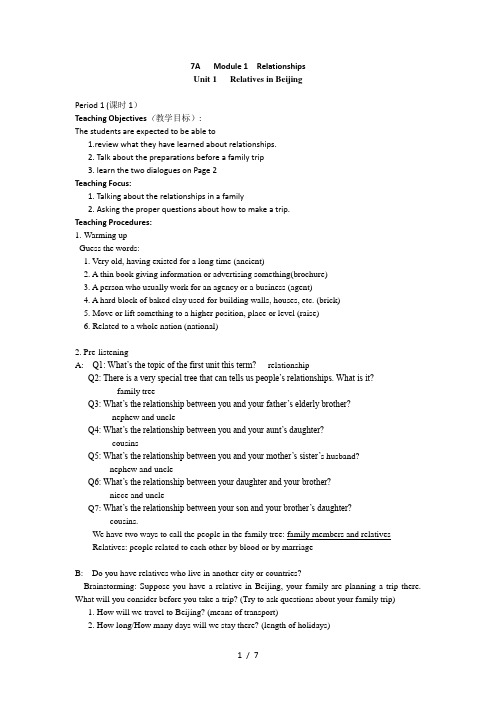
7A Module 1 RelationshipsUnit 1 Relatives in BeijingPeriod 1 (课时1)Teaching Objectives(教学目标):The students are expected to be able to1.review what they have learned about relationships.2. Talk about the preparations before a family trip3. learn the two dialogues on Page 2Teaching Focus:1. Talking about the relationships in a family2. Asking the proper questions about how to make a trip.Teaching Procedures:1.Warming upGuess the words:1. Very old, having existed for a long time (ancient)2. A thin book giving information or advertising something(brochure)3. A person who usually work for an agency or a business (agent)4. A hard block of baked clay used for building walls, houses, etc. (brick)5. Move or lift something to a higher position, place or level (raise)6. Related to a whole nation (national)2. Pre-listeningA: Q1: What’s the topic of the first unit this term?----relationshipQ2: There is a very special tree that can tells us people’s relationships. What is it?----family treeQ3: What’s the relationship between you and your father’s elderly brother?--- nephew and uncleQ4: What’s the relationship between you and your aunt’s daughter?--- cousinsQ5: What’s the relationship between you and your mother’s sister’s husband?---nephew and uncleQ6: What’s the relationship between your daughter and your brother?---niece and uncleQ7: What’s the relationship between your son and your brother’s daughter?---cousins.We have two ways to call the people in the family tree: family members and relativesRelatives: people related to each other by blood or by marriageB: Do you have relatives who live in another city or countries?Brainstorming: Suppose you have a relative in Beijing, your family are planning a trip there. What will you consider before you take a trip? (Try to ask questions about your family trip)1. How will we travel to Beijing? (means of transport)2. How long/How many days will we stay there? (length of holidays)3. How much will we spend? (costs)4. Which place of interest/tourist attraction are we going to visit there?5. If we travel by air, how long will it take to travel from Shanghai to Beijing?6. If we travel by high-speed train, how long will it take us to travel from Shanghai to Beijing? *Try to make use of the questions to make a dialogue with your deskmate about planning a trip to Beijing.3. While-listeningA: Listen to “Listen and say” twice with your textbooks closed and answer questions.Q1: Who is the letter from? ----Ben's uncle, Weiming.Q2: Has Ben seen his cousins before? ---No, he hasn't.Who are they? How old are they? --- Two. Lucy is ten. Simon is twelve.Q3: What does Ben's Uncle want Ben's family to do in August?He has invited his family to stay with them in August.Q4: In the end, how do they decide to travel to Beijing? Why?-- By train. Because it's cheaper and interesting.Q5: Why don't they choose to travel by air? -- Because plane tickets are very expensive.Q6: What is Ben going to do after the talk with his father? --To get some brochures from the travel agent.B: Ask the Ss to read the dialogue.4. Language study1. relative n. relationship n.What’s the relationship between France and Germany?A be related to BEnglish is closely related to Germany.2. plan v. planned planning1) plan sth. plan a trip to Beijing2) plan to do sth. plan to travel to Beijingn. 1) make a plan for the coming holiday/our trip to Beijing2) the floor plan of the building(When you arrive at the hotel in Beijing, what should you do first?You should find and read the floor plan to look for the fire exit.)3. trip n. take / have / make / go on a trip to sp.I want to book a round-trip ticket to Beijing. ( cf. one-way ticket)This summer, some of our students made a school trip to Australia.a business trip a plane/train/boat tripjourney n. Wish you a pleasant journey!tour n. tourist tourismmake a tour around the worldTailand is famous for its tourism.travel v. traveler n. travel to ….n. travel plan/travel agency/travel brochures4. invite v. (an) invitation n. inviter -- receiverreceive an invitation from sb.* invent invention inventor1) invite sb. to sp. invite him to the party2) invite sb. to do sth. invite Ben to stay with his uncle's family5. talk vi. talk to / with sb. talk about sb./ sth. cf. say, speak , telln. have a talk with sb. = have a word with sb.give a talk on Chinese history / a talkative person6. expensive adj. inexpensive (ant.) expense n.travel expenses/living expenses/medical expenses (high/low)******************************************************************************* Period 2 (课时2)Teaching Objectives(教学目标):The students are expected to be able to1.review what they have learned on Page2.2. express preferences3. ask questions to find out the length of a period of time.Teaching Focus:1. Practising the sentence patterns: It takes...to do sth./ Sb. spend .....(in) doing sth./Sth. cost .. Teaching Procedures:I. Review.1. Ask the Ss to read the dialogue on Page2.2. Retell the dialogue according to the key words in five or six sentences:a letter/ invite/ photo/ cousins/ by air/by train/ brochureII. Learn the key words on Page 2.III. Check the homework ( make sentences with spend/take/cost)1. It takes/took sb....to do sth.2. Sb. spend time (in) doing sth.3. Sb. spend money on sth.4. Sth. cost sb. moneyIV. Say and Act: At the travel agent's1. Q: What are Ben and his father going to do after they talk about their travel plan?Turn to page 3 and find out what is happening at the travel agent's?*agent : at the travel agent's= at the travel agencyCIA( Central Intelligence Agency)V. Homework: Preview Page 4 and finish the letter on P4 and the letter on WB P4Teaching Objectives(教学目标):The students are expected to be able to1.review what they have learned on Page 3.2. use How- questions to find out length of time in the future tense.3. use adjectives to make comparisons.Teaching Focus:1. Practising the sentence patterns: How long are we going to...?Teaching Procedures:I. Listen and Say (Page 4)1. Listen to the dialogue and answer the questions.1) Which place are they going to pay a visit to? ---Beijing2) When are they going to visit Beijing? ---On 16 August.3) How long are they going to stay there? --- For two weeks.4) When are they going to return? ---At the end of August.5) How are they going to travel there? ---By plane.6) Why aren't they going to take the train there? ---The train is slower than the plane.7) How many hours does it take to travel by train from Garden City to Beijing? ---15 hours.2. Turn to Page 4 and read the dialogue.II. Word Study1. How long现在完成时:How long have you studied here?一般过去时:How long did he stay in Beijing last year?一般将来时:How long will you stay in Beijing? ---For two weeks.易错题:How soon will you go to Beijing? ---In two weeks.How long have you kept this book?How long has he been dead?2. at the end of the road …/ summer at the beginning of our talkin the end, = at last, finally,by the end of...* At the end of this year, we will travel to France.By the end of this year, we will have learned 500 new words.By the end of last year, we had learned 500 new words.3. during one's stay in...When Ben stayed in Beijing, he visited many places of interest.=During Ben's stay in Beijing, ......III. Check the answers in Read and Write and WB P41. Introduce the letter format.2. Introduce how to write a reply letter.1) Greetings (beginning/end) 2) Express your thanks3) Tell your travel time( arrival time, length of your stay, means of transportation, brief reasons)Teaching Objectives(教学目标):The students are expected to be able to1.review what they have learned on Page 4.2. use proper nouns or adverbs to show position.3. learn the passage on Page 5.Teaching Focus:1. The usage of preposition: withTeaching Procedures:I. Revision.1. Practise the dialogues on PPT (P4).2. Complete the summary of the dialogues on P2-4.II. Reading: Welcome to Beijing (P5)1. Turn to Page 5 and read the passage.2. Ask the Ss to read the passage carefully and try to ask questions about each part.(Every group is responsible for one paragraph.)3. Read the passage again and finish the exercise on WB P6--a summary.III. Word Study1. sp. lie / be located / be in the north-west of / in the center ofon the north of /to the north of / north ofEx. 1) 浙江在上海南部。
- 1、下载文档前请自行甄别文档内容的完整性,平台不提供额外的编辑、内容补充、找答案等附加服务。
- 2、"仅部分预览"的文档,不可在线预览部分如存在完整性等问题,可反馈申请退款(可完整预览的文档不适用该条件!)。
- 3、如文档侵犯您的权益,请联系客服反馈,我们会尽快为您处理(人工客服工作时间:9:00-18:30)。
7A Module 1 RelationshipsUnit 1 Relatives in BeijingPeriod 1 (课时1)Teaching Objectives(教学目标):The students are expected to be able to1.review what they have learned about relationships.2. Talk about the preparations before a family trip3. learn the two dialogues on Page 2Teaching Focus:1. Talking about the relationships in a family2. Asking the proper questions about how to make a trip.Teaching Procedures:1.Warming upGuess the words:1. Very old, having existed for a long time (ancient)2. A thin book giving information or advertising something(brochure)3. A person who usually work for an agency or a business (agent)4. A hard block of baked clay used for building walls, houses, etc. (brick)5. Move or lift something to a higher position, place or level (raise)6. Related to a whole nation (national)2. Pre-listeningA: Q1: What’s the topic of the first unit this term?----relationshipQ2: There is a very special tree that can tells us people’s relationships. What is it?----family treeQ3: What’s the relationship between you and your father’s elderly brother?--- nephew and uncleQ4: What’s the relationship between you and your aunt’s daughter?--- cousinsQ5: What’s the relationship between you and your mother’s sister’s husband?---nephew and uncleQ6: What’s the relationship between your daughter and your brother?---niece and uncleQ7: What’s the relationship between your son and your brother’s daughter?---cousins.We have two ways to call the people in the family tree: family members and relativesRelatives: people related to each other by blood or by marriageB: Do you have relatives who live in another city or countries?Brainstorming: Suppose you have a relative in Beijing, your family are planning a trip there. What will you consider before you take a trip? (Try to ask questions about your family trip)1. How will we travel to Beijing? (means of transport)2. How long/How many days will we stay there? (length of holidays)3. How much will we spend? (costs)4. Which place of interest/tourist attraction are we going to visit there?5. If we travel by air, how long will it take to travel from Shanghai to Beijing?6. If we travel by high-speed train, how long will it take us to travel from Shanghai to Beijing? *Try to make use of the questions to make a dialogue with your deskmate about planning a trip to Beijing.3. While-listeningA: Listen to “Listen and say” twice with your textbooks closed and answer questions.Q1: Who is the letter from? ----Ben's uncle, Weiming.Q2: Has Ben seen his cousins before? ---No, he hasn't.Who are they? How old are they? --- Two. Lucy is ten. Simon is twelve.Q3: What does Ben's Uncle want Ben's family to do in August?He has invited his family to stay with them in August.Q4: In the end, how do they decide to travel to Beijing? Why?-- By train. Because it's cheaper and interesting.Q5: Why don't they choose to travel by air? -- Because plane tickets are very expensive.Q6: What is Ben going to do after the talk with his father? --To get some brochures from the travel agent.B: Ask the Ss to read the dialogue.4. Language study1. relative n. relationship n.What’s the relationship between France and Germany?A be related to BEnglish is closely related to Germany.2. plan v. planned planning1) plan sth. plan a trip to Beijing2) plan to do sth. plan to travel to Beijingn. 1) make a plan for the coming holiday/our trip to Beijing2) the floor plan of the building(When you arrive at the hotel in Beijing, what should you do first?You should find and read the floor plan to look for the fire exit.)3. trip n. take / have / make / go on a trip to sp.I want to book a round-trip ticket to Beijing. ( cf. one-way ticket)This summer, some of our students made a school trip to Australia.a business trip a plane/train/boat tripjourney n. Wish you a pleasant journey!tour n. tourist tourismmake a tour around the worldTailand is famous for its tourism.travel v. traveler n. travel to ….n. travel plan/travel agency/travel brochures4. invite v. (an) invitation n. inviter -- receiverreceive an invitation from sb.* invent invention inventor1) invite sb. to sp. invite him to the party2) invite sb. to do sth. invite Ben to stay with his uncle's family5. talk vi. talk to / with sb. talk about sb./ sth. cf. say, speak , telln. have a talk with sb. = have a word with sb.give a talk on Chinese history / a talkative person6. expensive adj. inexpensive (ant.) expense n.travel expenses/living expenses/medical expenses (high/low)******************************************************************************* Period 2 (课时2)Teaching Objectives(教学目标):The students are expected to be able to1.review what they have learned on Page2.2. express preferences3. ask questions to find out the length of a period of time.Teaching Focus:1. Practising the sentence patterns: It takes...to do sth./ Sb. spend .....(in) doing sth./Sth. cost .. Teaching Procedures:I. Review.1. Ask the Ss to read the dialogue on Page2.2. Retell the dialogue according to the key words in five or six sentences:a letter/ invite/ photo/ cousins/ by air/by train/ brochureII. Learn the key words on Page 2.III. Check the homework ( make sentences with spend/take/cost)1. It takes/took sb....to do sth.2. Sb. spend time (in) doing sth.3. Sb. spend money on sth.4. Sth. cost sb. moneyIV. Say and Act: At the travel agent's1. Q: What are Ben and his father going to do after they talk about their travel plan?Turn to page 3 and find out what is happening at the travel agent's?*agent : at the travel agent's= at the travel agencyCIA( Central Intelligence Agency)V. Homework: Preview Page 4 and finish the letter on P4 and the letter on WB P4Teaching Objectives(教学目标):The students are expected to be able to1.review what they have learned on Page 3.2. use How- questions to find out length of time in the future tense.3. use adjectives to make comparisons.Teaching Focus:1. Practising the sentence patterns: How long are we going to...?Teaching Procedures:I. Listen and Say (Page 4)1. Listen to the dialogue and answer the questions.1) Which place are they going to pay a visit to? ---Beijing2) When are they going to visit Beijing? ---On 16 August.3) How long are they going to stay there? --- For two weeks.4) When are they going to return? ---At the end of August.5) How are they going to travel there? ---By plane.6) Why aren't they going to take the train there? ---The train is slower than the plane.7) How many hours does it take to travel by train from Garden City to Beijing? ---15 hours.2. Turn to Page 4 and read the dialogue.II. Word Study1. How long现在完成时:How long have you studied here?一般过去时:How long did he stay in Beijing last year?一般将来时:How long will you stay in Beijing? ---For two weeks.易错题:How soon will you go to Beijing? ---In two weeks.How long have you kept this book?How long has he been dead?2. at the end of the road …/ summer at the beginning of our talkin the end, = at last, finally,by the end of...* At the end of this year, we will travel to France.By the end of this year, we will have learned 500 new words.By the end of last year, we had learned 500 new words.3. during one's stay in...When Ben stayed in Beijing, he visited many places of interest.=During Ben's stay in Beijing, ......III. Check the answers in Read and Write and WB P41. Introduce the letter format.2. Introduce how to write a reply letter.1) Greetings (beginning/end) 2) Express your thanks3) Tell your travel time( arrival time, length of your stay, means of transportation, brief reasons)Teaching Objectives(教学目标):The students are expected to be able to1.review what they have learned on Page 4.2. use proper nouns or adverbs to show position.3. learn the passage on Page 5.Teaching Focus:1. The usage of preposition: withTeaching Procedures:I. Revision.1. Practise the dialogues on PPT (P4).2. Complete the summary of the dialogues on P2-4.II. Reading: Welcome to Beijing (P5)1. Turn to Page 5 and read the passage.2. Ask the Ss to read the passage carefully and try to ask questions about each part.(Every group is responsible for one paragraph.)3. Read the passage again and finish the exercise on WB P6--a summary.III. Word Study1. sp. lie / be located / be in the north-west of / in the center ofon the north of /to the north of / north ofEx. 1) 浙江在上海南部。
